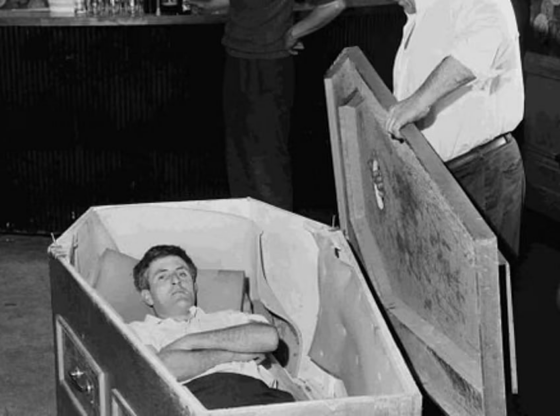Mick Meaney made headlines around the world when he broke an unusual world record in 1968: longest time spent buried alive in a coffin.
At a time when he was experiencing financial difficulties, this Irish worker believed that if he remained underground in a coffin longer than anyone else, the world would remember his name.
On February 21 of that year, onlookers and news crews followed his coffin, 1.90 m long and 76 cm wide and lined with foam, in a procession through the streets of Kilburn, the heart of the Irish immigrant community in London, while Meaney was buried in a ditch on a construction site.
The coffin was buried in the ground, with only a tube for air intake and through which food and liquids were delivered.
Meaney achieved his goal of breaking the world record and achieving fame, but he also believed that this feat could earn him money, which did not materialize.
The feat and its moving consequences will now be told in a documentary that will be shown on the Irish-language television channel TG4 on November 26th. Titled Beo Faoin bhFód (Buried Alive), the film has already been shown at festivals. Directed by Daire Collins, it combines interviews with Meaney’s family and friends with archive footage.
“My father was a proud Tipperary man. He was more of an Irishman, those who are now called the forgotten Irish, who worked there with pick and shovel and sent the money home to their families. Times were hard back then,” said Mick Meaney’s daughter, Mary, in the documentary.
Meaney, a robust man who dreamed of being a boxing champion, ended up digging tunnels in London after an accident left him under rubble.
Before him, the record remained held by an American, a Texan named Bill White, who was buried alive for 55 days.
To beat that record, Meaney, then 33, enlisted the help of Michael “Butty” Sugrue, a circus performer turned bar owner and businessman in London’s Irish community.
A truck transported the coffin to land belonging to a contractor, Mick Keane, who provided part of the site for the stunt. A trapdoor that gave access to a cavity beneath the coffin, slightly larger than a common coffin, served as a bathroom.
“I slept very well last night,” Meaney told a newscaster on his second day in burial via a telephone installed inside his coffin. Underground, he established a routine: waking up at 7am, doing exercise compatible with confinement, applying ointment to his body, eating, reading books and newspapers and talking to people on the phone.
Interest in Meaney’s challenge faded as the weeks went by, at a time when the Vietnam War and the assassination of Martin Luther King dominated the spotlight.
The coffin was unearthed and transported on top of a truck 61 days later, on April 22, passing through celebrating crowds until arriving at a pub. When the lid was removed, Meaney, wearing sunglasses to protect his eyes and beard, smiled. “I would like to continue for another hundred days. I am delighted to be world champion,” he told the company.
Meaney thought that after leaving the coffin he would go on a world tour and be sponsored by Gillette, but this never materialized. “In every area of life, there are people who simply use you as a vampire,” said Mary Meaney, saying that her father returned to Ireland “without even a bottle’s worth of milk in his pocket.”
As if that weren’t enough, no representative of the Guinness Book of Records recorded Meaney’s feat. And, also in 1968, a former nun called Emma Smith allowed herself to be buried under a fairground in Skegness for 101 days.

